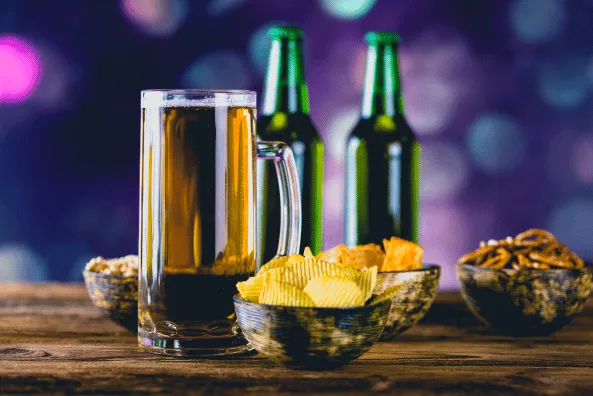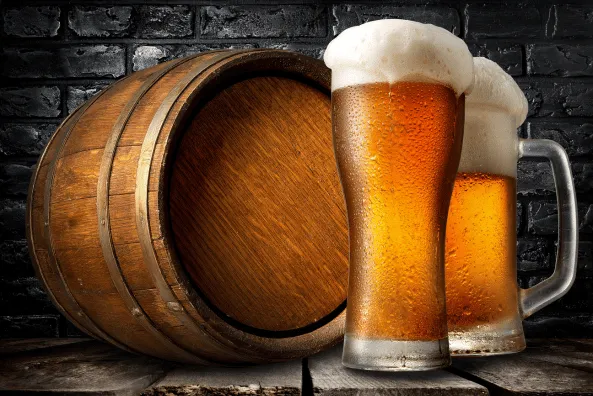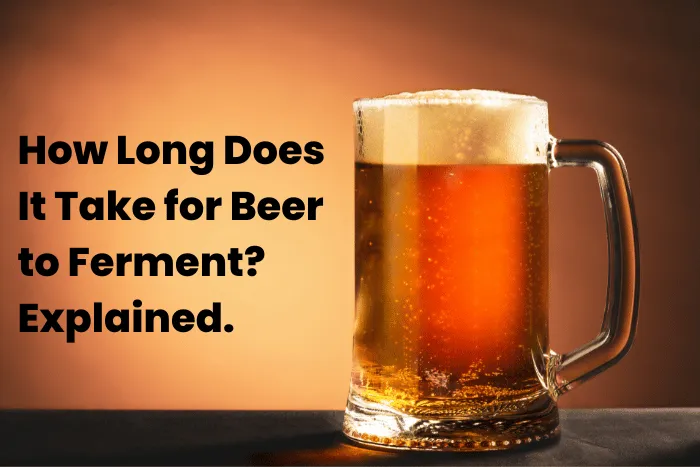If you’re an avid homebrewer or just starting, understanding the brewing process is key. In this blog post, we’ll explore fermentation and its impact on beer flavor. In particular, we’ll cover how long beer fermenting takes.
Firstly, we’ll discuss what happens during primary fermentation when yeast begins to convert sugars into alcohol. We’ll also explore different types of yeast strains and their impact on flavor profiles. Next, we’ll move on to secondary fermentation, where the remaining yeast continues to break down any remaining sugars.
We will then delve into temperature control during the primary and secondary fermentation stages and discuss various types of vessels used for fermenting beer. Additionally, we’ll explain how priming sugar can be added before bottling to create carbonation through bottle conditioning.
Finally, we’ll provide some tips on how commercial breweries approach these processes differently from home brewers concerning liquid yeast cultures versus dry yeasts.
By the close of this article, you should have a comprehensive grasp on all topics linked to fermenting beer to advance your brewing abilities!
Table of Contents:
- The Brewmaking Process
- Fermentation Timeframe
- Yeast Strains & Fermentation Temperature
- Stages Of Beer Fermentation
- Bottling vs Kegging Beers
- FAQs in Relation to How Long Does it Take for Beer to Ferment
- Conclusion
The Brewmaking Process
Brewing beer is an exciting and rewarding process. The process of brewing beer can range from a fortnight to four weeks, depending on the type.
Sanitation:
The first step in brewing any beer is sanitation. Sanitation is key for ensuring your brew turns out clean and free from bacteria or wild yeast. Once you have sanitized all your equipment, it’s time to begin the brew day.
Mashing:
For all-grain brewers, mashing involves steeping grains in hot water at certain temperatures for specific amounts. This helps convert starches into sugars used by yeast during fermentation. Extract kits involve boiling malt extract with hops and other ingredients like spices or fruit before transferring it into a fermenter, where it will cool down before adding yeast.
Yeast Strain Selection:
Yeast strain selection plays an important role when making beer, as different strains create unique flavors and aromas in finished beers. Ale yeasts tend to be more robust than lager yeasts, requiring higher fermentation temperatures (60-72F), while lagers prefer cooler temps (45-55F).
Yeast begins working shortly after pitching, breaking down sugar molecules into alcohol and carbon dioxide gas, giving the beer its signature fizziness once bottled or kegged.
Fermentation:
As fermentation progresses, remaining yeast cells sink to the bottom of the vessel, forming sediment called trub which should be left behind when bottling/kegging for clearer beers without off flavors caused by too much trub contact with liquid beer during conditioning time post-fermentation phase.
Before bottling or kegging, homebrewers may choose to add priming sugar which provides food for remaining active yeast cells, allowing them to produce additional CO2 inside bottles creating natural carbonation instead of using pressurized CO2 tanks like commercial breweries. When using dry packeted yeast, it is best practice to activate them before pitching by rehydrating them according to room temperature instructions provided on the packaging. However, liquid yeasts don’t need this step as they are ready to use immediately.
After primary fermentation has been completed, transfer the wort onto a secondary fermenter if desired and let it sit for a few days longer to help clarify further before moving onto the bottle conditioning stage, where final touches such as flavorings can be added. A 10-day aging period is recommended to give beers enough time to condition properly and taste great.
Fermentation Timeframe
Fermenting is a vital part of the beer-making process, and comprehending fermentation periods can aid in producing preferred brews. Fermenting times can vary contingent on multiple elements, like the temperature, yeast strain, and beer type.
Ale yeast strains are generally more active than lager yeast strains at warmer temperatures. Ale yeasts are most active between 60-75°F (15-24°C), but they can still work within a wide temperature range of 50-85°F (10-29°C), while larger yeasts need cooler temperatures, 45-55°F (7-13°C), for optimal fermentation.
For optimal results, lagers prefer cooler temperatures between 45-55°F (7-13°C). Lager yeasts take longer to ferment at these lower temperatures than ale yeasts.
For example, some ales may be ready in 7 days while lagers may take up to 14 days or longer depending on the strain and other variables such as gravity levels and initial pitching rate of the yeast cells into your wort/beer mixture before primary fermentation begins.
Yeast Strains & Fermentation Temperature

Brewing beer necessitates comprehension of yeast strains and fermentation temperatures for successful results. The kind of yeast and the warmth it ferments can impact your brew’s flavor characteristics and excellence.
Ale Yeasts:
Ale Yeasts are known for their ability to produce a wide range of flavors in beers. It typically works best at temperatures ranging from 60-70°F (15-21°C). These yeasts can make ales such as pale ales, IPAs, stouts, porters, wheat beers, and Belgian styles. Ale yeasts ferment quickly – usually within one week – and leave residual sweetness behind due to unfermented sugars. This can result in a fuller body or higher alcohol content than other beer styles.
Lager Yeasts:
Lager yeasts are more delicate than ale yeasts and require cooler temperatures for optimal fermentation – usually between 45-55°F (7-13°C). Lagers tend to have a cleaner taste than ales due to their slower fermentation rate; this allows more time for the remaining yeast cells in suspension during conditioning time after primary fermentation has completed. Lagers also require priming sugar added before bottling, which helps create carbonation from additional yeast activity once bottled at room temperature over several days or weeks, depending on the desired level of carbonation. Liquid lager yeast cultures may take up to 10 days or longer until all signs of active fermentation cease completely before moving onto the secondary conditioning phase, where they’ll sit until ready for consumption or packaging into bottles or kegs depending on preference.
Yeast strains and fermentation temperature are important factors to consider when brewing beer, as they will affect the flavor of your final product. Moving on, let’s discuss the stages of beer fermentation in more detail.
Stages Of Beer Fermentation
Beer creation involves transforming sugar into alcohol, a key element in beer production. It occurs in three distinct stages: lag phase, exponential growth stage, and stationary phase.
Lag Phase:
The lag phase begins fermentation when yeast feeds on sugars found in the wort (unfermented beer). During this time, oxygen intake allows cell wall constituents to be produced while yeast cells reproduce rapidly. This period may last from several hours to a few days, contingent on components such as the strain of yeast utilized, the temperature in the fermentation vessel, and available nutrients.
Exponential Growth Stage:
Once the lag phase ends, the exponential growth stage begins, where rapid cell count and ethanol production increase occur simultaneously. Yeast cells consume available sugars until they reach their maximum capacity or are inhibited by other environmental conditions like high temperatures or low pH levels.
The duration of this stage depends largely on how much sugar is left for them to consume but typically lasts between 5-10 days at room temperature before transitioning into the next phase.
Stationary Phase:
Brewing beer is a complicated procedure requiring diligence and expertise, yet the outcome makes it all worthwhile. Gaining insight into the phases of fermentation can lead to brewers crafting delightful beers with distinctive tastes and fragrances. Now let’s look at how long carbonate bottled vs. kegged beers takes.
Bottling vs. Kegging Beers

When packaging finished beer, the two main methods are bottling and kegging. Both processes have merits and drawbacks that should be considered based on the beer requirements.
Bottled Beers:
Bottled beers typically require a longer conditioning time, as much as ten days or more, for optimal carbonation. The process is relatively simple; you add priming sugar to the bottles before filling them with beer from your fermentation vessel. This provides additional food for the remaining yeast cells in the beer, allowing them to generate carbon dioxide, which will give your bottled beers that desirable level of fizziness when opened.
Kegged Beers:
Kegged beers offer a much faster way of getting those bubbles into your brews – usually taking less than five minutes. To do this correctly, you need a pressurized system set up so that you can force carbon dioxide into the keg at room temperature while simultaneously releasing excess pressure through an adjustable valve. This allows CO2 gas to dissolve in solution inside the keg, creating that perfect level of carbonation without waiting for weeks, like bottle conditioning.
The preference between bottling and kegging is contingent on how fast you need your fizz and the equipment at hand. If time isn’t an issue, then adding priming sugar and letting it condition over several days might be best suited for most homebrewers out there looking for great tasting results without needing any specialized gear. On top of that, if done right bottle conditioned beers can often develop more complex flavors due to prolonged contact between yeast and sugars during fermentation which makes them worth considering too.
FAQs in Relation to How Long Does it Take for Beer to Ferment
How long does a beer take to ferment?
The time it takes for beer to ferment depends on the type of beer being made and the temperature at which fermentation occurs. Typically, ales need around two weeks for primary fermentation to finish, whereas lagers could take up to six weeks or more. Fermentation times can also be affected by yeast strain and pitching rate. Determining when a beer has finished fermenting can be done by monitoring gravity readings over time until they remain stable.
Are 2 weeks long enough to ferment beer?
Generally speaking, two weeks is probably not long enough to ferment beer. Brewers must be mindful that fermentation can take one week to multiple months, depending on the beer and process employed. Brewers must persist in waiting for the right amount of time to produce a beer that meets their standards.
Can beer ferment in 7 days?
Ales are often ready to drink in a week, provided they are kept at the ideal temperature range. Lagers take more time to ferment than ales, given the lower temperatures needed for brewing. Ales can usually be fermented within a week if kept at an optimal temperature range (68-72°F). Consider utilizing dry yeast or upping the amount of yeast used for faster fermentation. Additionally, adding oxygen before pitching your yeast will also help speed up the process.
How long should primary fermentation last?
Primary fermentation duration may range from two to four weeks, contingent on the type of beer. During this time, yeast consumes sugars in the wort to produce alcohol and carbon dioxide. Temperature is an important factor during primary fermentation as it can affect how quickly yeast will work and the quality of flavor produced. To ensure a successful ferment, keep temperatures consistent throughout the process for optimal results.
Conclusion
Creating beer at home is a fulfilling experience that requires patience, but the end product can be immensely rewarding. It takes patience, but the results are worth it when you have your homemade craft brew. The time it takes for beer to transform through the fermentation procedure varies, contingent upon various elements like yeast choice, temperature maintenance, and tracking. With some basic knowledge about fermentation processes and troubleshooting common problems with beer fermentation, anyone can quickly create their own delicious beers.
Discover the best beer reviews, equipment, and subscription services to make your brewing experience easier. Learn how long your beer will ferment with our expert tips and advice!
Also Visit: Exploring the Differences Between Helles and Pilsner Beers
